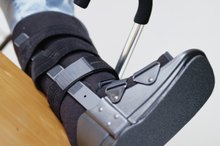Can You Cycle with a Tibia Stress Fracture
Your lower leg is made up of two bones that connect together below your knee: the tibia and the fibula. The tibia is the larger of your two lower leg bones and absorbs much of the shock when you perform high-impact activities, such as running and jumping. If you experience a tibial stress fracture, your physician may clear you for activities such as cycling as long as you take careful precautions 4. Always speak with your physician, however, before performing any exercise following a tibial stress fracture 4.
If you are experiencing serious medical symptoms, seek emergency treatment immediately.
Time Frame
After experiencing a tibial stress fracture, many athletes claim their pain is more significant after a long training session, according to SportsMD.com 4. This means when you are resuming your cycling sessions, you may wish to limit them to shorter rides, such as 10 to 15 minutes, until you have given your stress fracture more time to heal. If you experience aching, throbbing pain or swelling at the stress fracture site, these can indicate you may have pushed yourself too far during your cycling session.
Shock Absorption
Cycling & Hip Bursitis
Learn More
Absorbing the shock of changing terrain can be a contributing factor to a tibial stress fracture 4. If your cycling sport of choice is mountain biking, you may need to re-think this when you initially experience your tibial stress fracture 4. This is because your tibia is responsible for absorbing the small impacts of going over a rock or bump. Over time, these can add up and potentially worsen your stress fracture. To keep this from occurring, you may wish to switch to more even terrain, such as riding a stationary bicycle or riding a road bicycle on an even road.
- Absorbing the shock of changing terrain can be a contributing factor to a tibial stress fracture 4.
Bracing/Taping
Your physician may suggest methods such as bracing and taping your foot to provide added stability to the tibia. These efforts may provide you extra support as you cycle. For example, your physician may recommend using athletic tape wrapped around your ankle and heel to prevent your ankle from rolling inward while you are biking.
Considerations
How to Treat Shin Splints
Learn More
A tibial stress fracture is the result of repetitive, continuous motion that weakens your bones 4. While cycling is less likely to cause a tibial stress fracture than high-impact activities such as running or playing football, it is possible that cycling could worsen your fracture 4. If you experience pain upon cycling, listen to your body and cease exercising. Most tibial stress fractures will heal within six to eight weeks and rest is an important component to your recovery. You may wish to mix cycling sessions with swimming, a non-impact activity, to prevent stress to your lower leg.
- A tibial stress fracture is the result of repetitive, continuous motion that weakens your bones 4.
- You may wish to mix cycling sessions with swimming, a non-impact activity, to prevent stress to your lower leg.
Related Articles
References
- SportsMD: Stress Fractures in the Lower Extremity
- SportsInjuryClinic.net: Tibia Stress Fracture
- Hospital for Special Surgery: Stress Fractures
- PhysioAdvisor.com: Tibial Stress Fracture
- American Family Physician: Common Stress Fractures
- Astur DC, Zanatta F, Arliani GG, Moraes ER, Pochini Ade C, Ejnisman B. Stress fractures: definition, diagnosis and treatment. Rev Bras Ortop. 2016;51(1):3-10. doi:10.1016/j.rboe.2015.12.008
- Ackerman KE, Cano sokoloff N, De nardo maffazioli G, Clarke HM, Lee H, Misra M. Fractures in Relation to Menstrual Status and Bone Parameters in Young Athletes. Med Sci Sports Exerc. 2015;47(8):1577-86. doi:10.1249/MSS.0000000000000574
- Wesner ML. Nutrient effects on stress reaction to bone. Can Fam Physician. 2012;58(11):1226-30.
- Wilder, Robert P. MD, FACSM, and Sethi, MD, Shikha.Clinics in Sports Medicine. Vol 23:1, Jan. 2004. MD Consult.
- Lappe, JM, Stegman, MR, and Recker, RR. (2001) The impact of lifestyle factors on stress fractures in female Army recruits. Osteoporosis International. 12(1):35-42.
Writer Bio
Rachel Nall began writing in 2003. She is a former managing editor for custom health publications, including physician journals. She has written for The Associated Press and "Jezebel," "Charleston," "Chatter" and "Reach" magazines. Nall is currently pursuing her Bachelor of Science in Nursing at the University of Tennessee.









